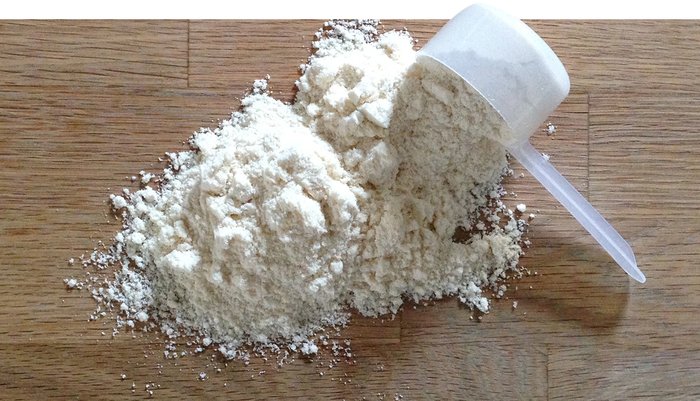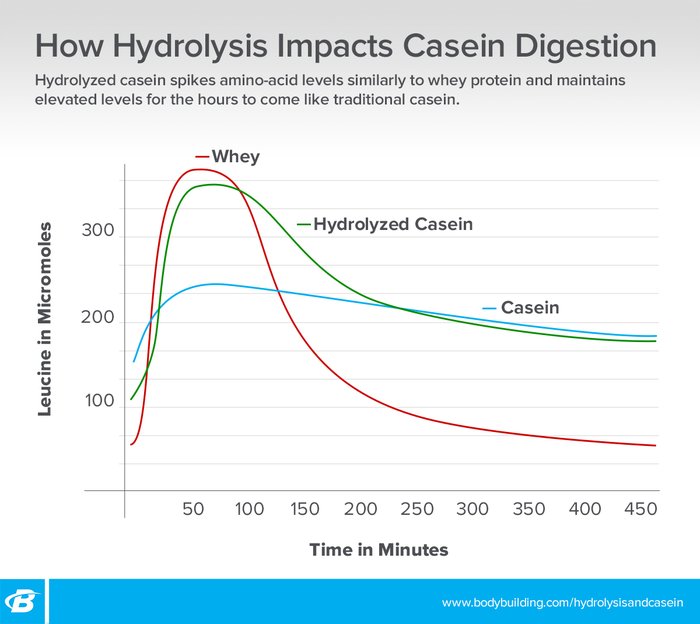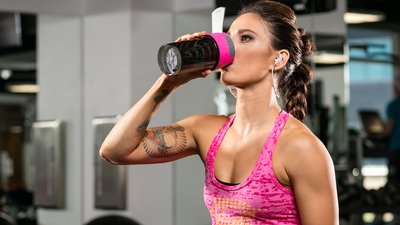When protein hydrolysates—often called hydrolyzed proteins—first hit the shelf in the early 2000s, not much was known about their impact on size and performance; we just knew they digested faster than traditional protein powders. Some people wondered if that actually made a difference, and labeled hydrolysates a gimmick. Now we know better.
A decade later, we now have more research to pull from, and both whey and casein hydrolysates are making a comeback. Will they ever be as popular as isolates or concentrates? Perhaps not, but beyond lightning-fast digestion, whey and casein hydrolysate offer serious advantages in certain situations. Here's what you need to know!
Hydro-What?
A protein hydrolysate refers to a protein that has been partially digested or "hydrolyzed." Don't worry, it's not as if someone began chewing your protein and spat it back out. This process involves adding proteolytic enzymes, which break down protein, or heating a protein with acid. Both mimic the digestion process and result in intact proteins breaking down into single amino acids and small amino-acid peptide strands.

Hydrolysis potentially fuels greater delivery of amino acids from your gut to your muscles, and it may also enhance the speed of delivery when compared to an intact protein.[1] As a result, there's less time for the liver to extract crucial amino acids as they flow outward to your muscles.[2,3] For that reason, more amino acids may reach your muscles.
In terms of nutrition and performance, here's how hydrolyzed protein stacks up against other proteins.
Benefit 1: More and Longer-Lasting Amino Acids
Whey protein hydrolysate has a higher leucine content compared to whey isolate: 14.2 percent versus 12.2 percent, to be specific.[4] Given that leucine is essential for "turning on" muscle building, this lift in delivery to your muscles may potentially provide a very slight edge over any other whey form, but the difference is far more pronounced in casein.
Traditional (intact) casein provides a slow, steady increase in amino-acid levels. It doesn't produce a pronounced spike in levels, which is why it's widely considered to be "anticatabolic"—take it before bed to stave off muscle breakdown—rather than anabolic.

Casein hydrolysate, on the other hand, has been shown to initiate a prominent spike in amino-acid levels similar to whey protein while still maintaining elevated amino-acid levels for the hours to come like that of traditional casein.[5] Even more impressive, a study published in Pharmacological Reviews found a 30 percent greater rise in muscle protein synthesis over a six-hour period when subjects consumed casein hydrolysate versus intact casein.[6]
Benefit 2: Enhanced Glycogen Replenishment
Replenishing glycogen with carbohydrates post-workout enhances the recovery process and prepares your body for your next workout, particularly if you're an athlete doing two-a-days or something similarly demanding.
Glycogen replenishment is fueled by insulin, which is robustly stimulated in the presence of carbs, but also stimulated in the presence of protein alone. Whey hydrolysate induces a substantially greater insulin response compared to intact proteins (isolate or concentrate), which may facilitate superior glycogen replenishment and a greater anabolic response when consumed post-workout.[7]
However, it's worth mentioning that according to a study published in the journal Amino Acids, the difference between hydrolysate and isolate was not noteworthy until 40 minutes. This may or may not be beneficial so far removed from a workout; more research is certainly needed to discern the implications and potential benefits.
Research conducted in mice and cell cultures demonstrated that consuming a whey hydrolysate and carbohydrate combination post-workout significantly increased glycogen replenishment two hours after the workout compared to a whey-isolate/carbohydrate combination and a branched-chain amino acid (BCAA) carbohydrate combination.[8]
Although this research has only been done in mice and cultures at this point, the authors speculate that similar findings would be found in human studies.
Benefit 3: Faster Recovery
A study published in the Journal of Science in Medicine and Sports found that subjects consuming whey hydrolysate post-workout experienced better recovery and performance shortly after a muscle-damaging bout of exercise than those consuming whey isolate.[2] Researchers had 28 subjects complete 100 eccentric-focused repetitions on the leg extension. An eccentric focus induces significantly more muscle damage than typical concentric movements.

Immediately following exercise, subjects consumed either 25 grams of whey hydrolysate, 25 grams of whey isolate, or a protein-free placebo. Recovery was assessed via blood markers, subjective ratings, and performance testing. Measures were completed 1, 2, 6, and 24 hours post-testing.
The whey-hydrolysate group was able to regain performance (measured as peak isometric torque) 6 hours later, whereas the placebo and whey isolate group had not yet fully recovered even 24 hours later. That's a serious difference!
Benefit 4: Improved Intra-Workout Performance
Several studies have observed the effect of consuming casein hydrolysates in addition to carbohydrates during endurance-based exercise.[9-11] Benefits observed include a greater net protein balance, increased time-trial performance, and workout-recovery support.
Though more research is needed on intra-workout protein consumption, these studies represent promising evidence in support of consuming a rapidly-digested protein during your workout.
Hydrolysate's Time Has Come
Today, there's significantly more research available looking at the impact of protein hydrolysates compared to 10 years ago.

And although we don't have definitive reasoning to ditch whey isolates, whey concentrates, or traditional casein, we do have information that suggests choosing a hydrolysate may be advantageous in specific situations:
Intense, frequent training: If you train twice per day, a whey hydrolysate may be advantageous to attenuate muscle damage and replenish glycogen quickly so that you're as close to 100 percent as possible for your second workout.
When dieting: For those deep into a dieting phase, choosing a whey hydrolysate post-workout may be advantageous to promote recovery in the presence of limited carbohydrates. It may also help you to maximize the muscle-building response with fewer calories, given than it has a significantly higher leucine content compared to whey isolate.
During long-duration training: If you're about to embark on a lengthy endurance workout, a casein hydrolysate may help to attenuate muscle breakdown and enhance overall performance.
References
- Calbet, J. A., & Holst, J. J. (2004). Gastric emptying, gastric secretion and enterogastrone response after administration of milk proteins or their peptide hydrolysates in humans. European Journal of Nutrition, 43(3), 127-139.
- Buckley, J. D., Thomson, R. L., Coates, A. M., Howe, P. R., DeNichilo, M. O., & Rowney, M. K. (2010). Supplementation with a whey protein hydrolysate enhances recovery of muscle force-generating capacity following eccentric exercise. Journal of Science and Medicine in Sport, 13(1), 178-181.
- Tang, J. E., Moore, D. R., Kujbida, G. W., Tarnopolsky, M. A., & Phillips, S. M. (2009). Ingestion of whey hydrolysate, casein, or soy protein isolate: effects on mixed muscle protein synthesis at rest and following resistance exercise in young men. Journal of Applied Physiology, 107(3), 987-992
- Bucci, L., & Unlu, L. (2000). Proteins and amino acid supplements in exercise and sport. Energy-Yielding Macronutrients and Energy Metabolism in Sports Nutrition, 191-212.
- Koopman, R., Crombach, N., Gijsen, A. P., Walrand, S., Fauquant, J., Kies, A. K., ... & van Loon, L. J. (2009). Ingestion of a protein hydrolysate is accompanied by an accelerated in vivo digestion and absorption rate when compared with its intact protein. The American Journal of Clinical Nutrition, 90(1), 106-115.
- Kim, W., & Egan, J. M. (2008). The role of incretins in glucose homeostasis and diabetes treatment. Pharmacological Reviews, 60(4), 470-512.
- Power, O., Hallihan, A., & Jakeman, P. (2009). Human insulinotropic response to oral ingestion of native and hydrolysed whey protein. Amino Acids, 37(2), 333-339.
- Morifuji, M., Kanda, A., Koga, J., Kawanaka, K., & Higuchi, M. (2010). Post-exercise carbohydrate plus whey protein hydrolysates supplementation increases skeletal muscle glycogen level in rats. Amino Acids, 38(4), 1109-1115.
- Beelen, M., Koopman, R., Gijsen, A. P., Vandereyt, H., Kies, A. K., Kuipers, H., ... & van Loon, L. J. (2008). Protein coingestion stimulates muscle protein synthesis during resistance-type exercise. American Journal of Physiology-Endocrinology and Metabolism, 295(1), E70-E77.
- Beelen, M., Tieland, M., Gijsen, A. P., Vandereyt, H., Kies, A. K., Kuipers, H., ... & van Loon, L. J. (2008). Coingestion of carbohydrate and protein hydrolysate stimulates muscle protein synthesis during exercise in young men, with no further increase during subsequent overnight recovery. The Journal of Nutrition, 138(11), 2198-2204.
- Saunders, M. J., Moore, R. W., Kies, A. K., Luden, N. D., & Pratt, C. A. (2009). Carbohydrate and protein hydrolysate coingestion's improvement of late-exercise time-trial performance. International Journal of Sport Nutrition,19(2), 136.

